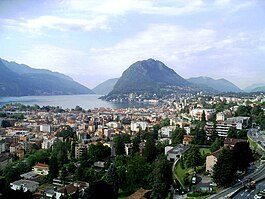Lugano, Switzerland
| Largest groups of foreign residents 2013 | ||
| Nationality | Amount | % total (foreigners) |
|---|---|---|
|
|
15,047 | 22.4 (58.0) |
|
|
1,400 | 2.0 (5.4) |
|
|
1,098 | 1.6 (4.3) |
|
|
949 | 1.4 (3.7) |
|
|
430 | 0.6 (1.7) |
|
|
428 | 0.6 (1.7) |
|
|
417 | 0.6 (1.6) |
|
|
360 | 0.5 (1.4) |
|
|
351 | 0.5 (1.4) |
|
|
345 | 0.5 (1.3) |
|
|
310 | 0.5 (1.2) |
|
|
284 | 0.4 (1.1) |
|
|
274 | 0.4 (1.0) |
Lugano (Italian pronunciation: [luˈɡaːno]; German: Lauis; Lombard: Lügàn) is a city in southern Switzerland in the Italian-speaking canton of Ticino bordering Italy. It has a population of 71,500, and an urban agglomeration over 145,000. The 9th largest Swiss city, it is the largest in Ticino and largest with an Italian speaking majority outside Italy.
The city lies on Lake Lugano, surrounded by the mountains of the Lugano Prealps. Its warm summers and reputation for attracting celebrities, entertainers, and successful athletes have earned it the nickname the "Monte Carlo of Switzerland".
The toponym is first recorded in 804, in the form Luanasco, in 874 as Luano, and from 1189 as Lugano. German-language variants of the name (now no longer in use) were Lowens, Lauis, Lauwis. The etymology of the name is uncertain, suggestions include derivation from lucus "grove", from a vulgar Latin lakvannus "lake-dweller" and from the god Lugus.
The blazon of the municipal coat of arms is Gules, a cross throughout argent, between the upper case serif letters "L", "V", "G" and "A" (respectively in the I, II, III and IV quarters). The coat of arms dates from around 1200. The four letters on the coat of arms are an abbreviation of the name Lugano.
The shores of Lake Lugano have been inhabited since the Stone Age. Within the modern city limits (Breganzona, Castagnola, Davesco and Gandria) a number of ground stones or quern-stones have been found. In the area surrounding Lugano, items from the Copper Age and the Iron Age have been found. There are Etruscan monuments at Davesco-Soragno (5th to 2nd century BC), Pregassona (3rd to 2nd century BC), and Viganello (3rd to 2nd century BC). Graves with jewelry and household items have been found in Aldesago, Davesco, Pazzallo and Pregassona along with Celtic money in Viganello.
...
Wikipedia




